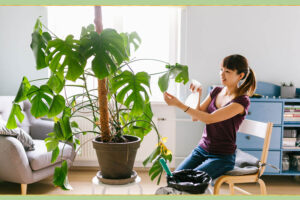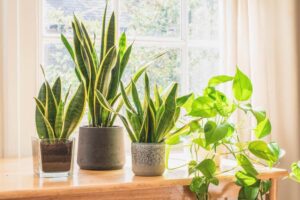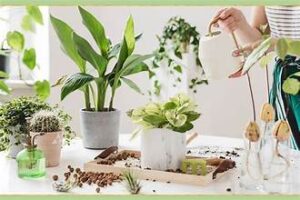
Indoor plants can transform any space into a lush, vibrant oasis. However, keeping them healthy and thriving throughout the year requires more than just occasional watering. In this comprehensive guide, we’ll cover essential indoor plant care hacks to ensure your plants remain in top condition, offering practical advice for both beginners and seasoned plant enthusiasts.
1. Choose the Right Plants for Your Space
Understanding Light Conditions:
The first step in successful indoor plant care is selecting plants that match your home’s light conditions. Some plants thrive in bright, direct sunlight, while others prefer lower light levels. For instance, succulents and cacti enjoy plenty of sunlight, whereas ferns and pothos can adapt to lower light conditions.
Consider Temperature and Humidity:
Plants also have specific temperature and humidity preferences. Tropical plants like peace lilies and orchids need warmer, more humid environments, while desert plants are adapted to dry conditions. Ensure you select plants that suit your home’s climate.
2. Optimize Light Exposure
Utilize Natural Light:
Place plants near windows where they can receive adequate natural light. South-facing windows typically offer the most light, but east and west-facing windows also provide beneficial exposure. Rotate your plants regularly to ensure even growth.
Supplement with Grow Lights:
If natural light is insufficient, consider using grow lights. These lights are designed to mimic the full spectrum of sunlight and can be adjusted to provide the right intensity and duration of light for your plants.
3. Watering Wisely
Understand Watering Needs:
Different plants have different watering requirements. Overwatering is a common mistake that can lead to root rot. To avoid this, check the soil moisture before watering. A general rule of thumb is to water when the top inch of soil feels dry.
Use Proper Drainage:
Ensure your pots have drainage holes to prevent water from accumulating at the bottom. This helps to avoid waterlogging and root rot. Use a well-draining potting mix suited to your plant type.
4. Maintain Proper Humidity
Increase Humidity for Tropical Plants:
Tropical plants, such as ferns and orchids, often need higher humidity levels. You can increase humidity by placing a humidifier in the room or by grouping plants together to create a microenvironment with higher moisture.
Use Pebble Trays:
Another effective method is to place a shallow tray filled with water and pebbles beneath your plants. As the water evaporates, it adds moisture to the air around the plants.
5. Fertilize Correctly
Choose the Right Fertilizer:
Fertilizing your plants provides essential nutrients for growth. Use a balanced, water-soluble fertilizer or one specifically formulated for your plant type. Follow the manufacturer’s instructions to avoid over-fertilization.
Adjust Feeding Schedule:
During the growing season (spring and summer), feed your plants regularly, usually every 4-6 weeks. Reduce feeding during the dormant season (fall and winter) as plant growth slows down.
6. Prune and Clean Your Plants
Regular Pruning:
Pruning helps maintain plant shape, remove dead or diseased foliage, and encourage new growth. Use clean, sharp scissors or pruning shears to make cuts, and be sure to remove any yellowing or dead leaves.
Clean Leaves:
Dust can accumulate on plant leaves, reducing their ability to photosynthesize. Gently wipe leaves with a damp cloth or give them a shower with lukewarm water to keep them clean and healthy.
7. Pest and Disease Control
Monitor for Pests:
Keep an eye out for common indoor plant pests like spider mites, aphids, and mealybugs. Regularly inspect your plants and treat infestations promptly with insecticidal soap or neem oil.
Prevent Diseases:
Ensure good air circulation around your plants and avoid wetting the leaves to prevent fungal and bacterial diseases. If you notice signs of disease, remove affected parts and treat the plant with appropriate fungicides or bactericides.
8. Repotting and Transplanting
When to Repot:
Repotting is necessary when plants outgrow their containers or the soil becomes depleted. Signs that it’s time to repot include roots growing out of the drainage holes or slowed growth.
How to Repot:
Choose a pot that is 1-2 inches larger in diameter than the current one. Gently remove the plant from its old pot, loosen any compacted roots, and place it in the new pot with fresh potting mix.
9. Seasonal Care Adjustments
Winter Care:
During the winter months, indoor plants typically experience slower growth. Reduce watering and avoid fertilizing. Ensure plants are not exposed to cold drafts or heating vents that can dry out the air.
Summer Care:
In the summer, plants may require more frequent watering and higher humidity levels. Increase light exposure if possible, but be cautious of intense sunlight that can scorch leaves.
10. Creating a Plant Care Routine
Set Reminders:
Establishing a regular plant care routine can help you stay on top of watering, fertilizing, and other maintenance tasks. Use a calendar or a smartphone app to set reminders and keep track of your plant care schedule.
Keep a Plant Journal:
Consider keeping a journal to track your plants’ growth, any issues you encounter, and the care routines you follow. This can be a valuable reference for future care and troubleshooting.
Conclusion
By following these essential indoor plant care hacks, you can ensure your plants remain healthy and vibrant throughout the year. From selecting the right plants and optimizing light exposure to managing watering and humidity, these tips will help you create a thriving indoor garden. Embrace these practices, and you’ll enjoy the beauty and benefits of indoor plants for years to come.

